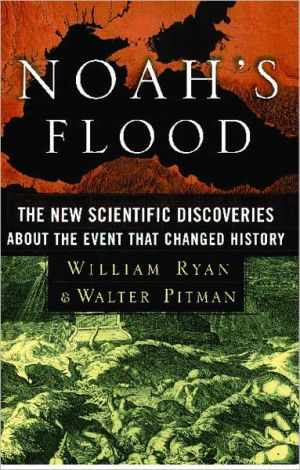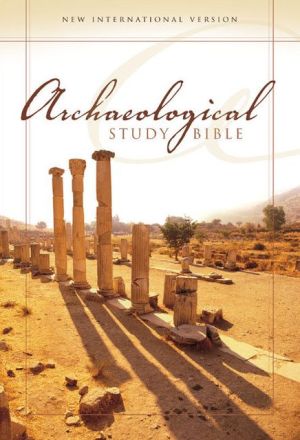Noah's Flood: The New Scientific Discoveries about the Event That Changed History
Over the millennia, the legend of a great deluge has endured in the biblical story of Noah and in such Middle Eastern myths as the epic of Gilgamesh. Now two distinguished geophysicists have discovered a catastrophic event that changed history, a gigantic flood 7,600 years ago in what is today the Black Sea. \ Using sound waves and coring devices to probe the sea floor, William Ryan and Walter Pitman revealed clear evidence that this inland body of water had once been a vast freshwater lake...
Search in google:
Over the millennia, the legend of a great deluge has endured in the biblical story of Noah and in such Middle Eastern myths as the epic of Gilgamesh. Now two distinguished geophysicists have discovered a catastrophic event that changed history, a gigantic flood 7,600 years ago in what is today the Black Sea.Using sound waves and coring devices to probe the sea floor, William Ryan and Walter Pitman revealed clear evidence that this inland body of water had once been a vast freshwater lake lying hundreds of feet below the level of the world's rising oceans. Sophisticated dating techniques confirmed that 7,600 years ago the mounting seas had burst through the narrow Bosporus valley, and the salt water of the Mediterranean had poured into the lake with unimaginable force, racing over beaches and up rivers, destroying or chasing all life before it. The rim of the lake, which had served as an oasis, a Garden of Eden for farms and villages in a vast region of semi-desert, became a sea of death. The people fled, dispersing their languages, genes, and memories.
Chapter Twenty: On a Golden Pond\ It was delightfully cool and fresh on the patio. From points across and down the near slope came the call to morning prayer. Two hundred and fifty feet below, the Bosporus flowed gently, glittering in the reflected light from the European side. In the night a warship had made passage, a reminder of the many armies and traders and wandering tribes that had crossed and recrossed this channel between Europe and Asia, the Black Sea and the Aegean, over thousands of years.\ At the Marmara end there is always a queue of ships anchored below the walls of the old city, above which loom the minarets of several mosques and the dome of Hagia Sophia. They wait to go north, upstream, to ports on the rim of the Black Sea. Once in the Bosporus strait they fight a gentle but constant southerly flow of water from the Black Sea and often hug the easterly shore, seeking the easy water. But this current against which even Jason and his Argonauts had to struggle is only at the surface, the upper fifty feet or so. On the bottom a dense salty layer flows northward from the Aegean through the Dardanelles, Sea of Marmara, and Bosporus, bringing Mediterranean water to the Black Sea. In a sense this countercurrent is a last vestige of the Great Flood. Before the age of motorboats, fishermen and others wishing to move upstream would lower a basket weighted with rocks into this bottom current and be towed northward toward the Black Sea by the hidden river.\ The Bosporus is almost two miles wide in the south, and narrows to half a mile in its middle course where it is bounded by steep slopes that reach to a plateau three hundred feet above. A layer of sediment of varying thickness masks the deep bedrock channel that was cut by the flood and is in places over four hundred feet deep. Below the patio on the Asian side of the strait lies the town of Anadoluhisari and across Rumelihisari, the remains of two forts built by Sultan Mehmet II during the siege of Constantinople. Darius is reputed to have bridged the Bosporus at this point.\ Ships ease by heading north and south, and at dawn the first of the ferryboats appear. In a few hours they will grow to a swarm plying back and forth and up and down. This gentle awakening to a new day belies the dramatic events that occurred there over seventy-six hundred years ago, drastically altering the landscape of the Bosporus and the entire area of the Black Sea and forcing a diaspora that changed the course of human history.\ But the story begins long before, back at the beginning of the last glacial cycle, 120,000 years ago when the Earth's climate and the level of the seas was about the same as today. From that point in time and for the next 100,000 years waters evaporated from the oceans and, transported by the winds, fell as snow on the near Arctic regions, gradually accreting and compressing into sheets of ice that were in some places up to two miles thick. Twenty thousand years ago at the zenith of this accumulation so much water had been withdrawn from the oceans that sea level was four hundred feet lower than today. Massive glaciers covered the entire northern half of North America, all of Scandinavia and northern Europe, and the northern edge of Eurasia. All the high mountains of Europe, Asia, North America, and South America were sheeted with ice down to their lowermost valleys.\ Modern man was there in Europe and Asia to witness and survive the extremity of this glacial episode. Having emerged from Africa about one hundred thousand years ago, the Moderns spread across Asia, rafted over to Australia, and finally entered Europe about thirty-five thousand years ago. Hunter-gatherers, they made stone tools and lived in temporary shelters and caves much like their very distant cousins the Neanderthals. But they brought with them qualities that their predecessors lacked, in particular an extraordinary ability to adapt and innovate. Their inventiveness is reflected in the rapid evolution of their hunting and survival skills.\ Twenty thousand years ago the great glacial meltdown began. Torrents of frigid waters raced to the sea, which slowly began to rise. Gradually the huge icy burden was removed from the land. In northern Russia rivers choked with meltwater flowed southward across the steppes and eventually spilled into the Black Sea's Ice Age lake. The icewater filled this lake to a level where it entered the Sakarya River, formed an estuary and advanced into the interior of Anatolia. Fifty miles in from the coast, this narrow and winding arm of the expanding lake found an outlet to the Sea of Marmara, having intercepted a cleft in the bedrock wrenched open through the grinding action of the North Anatolian fault (the locus of numerous large-magnitude deadly earthquakes delineating a zone of shear along which two of the earth's plates still slide past each other at the rate of inches per year). Exploiting the crushed and permeable rock in this crack, the meltwater passed through to the Mediterranean Sea. In the process, the Ice Age lake freshened and became potable for humans and animals.\ Those Moderns who lived in the north followed the great herds of mammoth, reindeer, and other large herbivores as they migrated across the tundra in front of the retreating glaciers. They lived in hunting camps for several months a year. On the Russian steppes where wood was scarce, they framed their lodges with mammoth bones, interlocked, tied together, and covered with skins. Meat was stored in pits dug into the frozen ground. They sewed skins into pants and boots, and made jackets with hoods.\ In the more temperate areas of Europe and Asia, the Moderns lived in round and oval huts of reeds or poles and skins sometimes built over a shallow pit. Fish were caught with hook and line and in traps and nets. They invented the bow and arrow, and the throwing stick that doubled the range of their hunting spears. Some may even have smoked and salted meat and fish. But life remained a day-to-day struggle for survival.\ As they met the challenge of this most difficult and demanding environment, there emerged from their creative impulses a most remarkable proliferation of art objects, often rendered with astonishing skill and finesse. Frequently quite decorative, many of these objects may have been created for aesthetic reasons only. But most seem to have been made for mystic and cultic purposes. Beads and amulets were carved of ivory, stone, and shells, and used to decorate clothes and to make necklaces and bracelets. Marvelous statuettes were sculpted of ivory, bone, and stone. Throwing sticks were carved into stylized images of horses, deer, and other animals they preyed upon. Weapons for the hunt, tools, and decorative objects such as bracelets and necklaces are found in graves with the body of the deceased as if these would be needed in some afterlife.\ The most spectacular of this "primitive" work are the cave paintings found for the most part in France and Spain. Usually rendered on the walls of chambers deep underground, they have been painted and scratched into the rock with extraordinary grace and skill. There are striking monochrome and multicolored paintings and line drawings of buffalo, deer, mammoths, horses, lions, hyena, and other animals and birds. Painted dots, chevrons, and silhouettes of hands are often interspersed among the figures of the animals. There are a few human portraits and several graceful drawings of the female figure. In many cases pictures have been superimposed on one another as if the act of drawing was important rather than the drawing itself. This artwork, sometimes quite realistic and at other times very abstract, has been found on the walls of caves and on cliffs, and even in a cave along the shore of the Mediterranean, long submerged by the rising sea level, and everywhere the Moderns roamed.\ A very clear and persistent manifestation of the spiritual and mystical nature of the Moderns are statuettes of women, interpreted almost universally as a symbol of fertility cult, found at sites throughout Europe, the Middle East, North Africa, and as far east as Lake Baikal in Siberia.\ Fifteen thousand years ago the glaciers were in full retreat, pouring millions of gallons of frigid meltwater into the rivers across North America and Eurasia. The colossal weight of these ice sheets impressed itself on the Earth's surface like a heavy object placed on a soft mattress. The weight on the mattress does not fill the dent entirely but is surrounded by a moat. Likewise the glaciers are often bordered by moats that trap meltwater, debris, and large chunks of ice that have broken away. Because in the northern hemisphere it was always warmer to the south, the glaciers melted mostly along their southern edge. As they retreated, the moat followed northward, across the steppes, trapping water and diverting flow to follow the channel parallel to the glacier front. By 13,000 B.C. the ice had withdrawn so far north that the flow of meltwater to the Black Sea had almost ceased.\ Europe was gripped by a return to the rigors of the glacial climate 12,500 years ago, an event known as the Younger Dryas, which lasted for a thousand years. Temperatures fell and the rains became scarce throughout southwest Asia, Europe, and Africa. Glaciers advanced in the high mountains. Lakes in Africa and Anatolia dried up. Precipitation in and around the Black Sea was low, so inflow was reduced to the point that the loss of water by evaporation from its surface exceeded the water received from the rivers and rainfall. The water level began to drop until it had fallen below the Sakarya outlet. Outflow ceased, and the Black Sea became an isolated lake.\ The Sakarya channel, no longer connected to either the lake or the sea, slowly collected mud and debris brought in by torrential seasonal rains and the flooding of its several streams. This debris built up slowly, forming a natural earthen dam. As the lake slowly drew down, it exposed an old shelf, a thick accumulation of the remains of marine organisms and rich sediments brought by the many rivers. The retreating waters, driven by winds and tides, sloshed back and forth, removing the silt from the uppermost layers of the sediments, leaving only the fragile shells of the delta mollusks, broken and bleaching in the sun. Sunbaked cracks filled with sand and seed of the wild wheats native to the area, some of which took root — especially in the more moist depressions and valleys. New sinuous valleys were cut right out to the shoreline, and detritus carried by the rivers in these valleys was deposited at the newly lowered lake edge, building new deltas that were bordered by the natural levees created during the occasional overflow. These valleys and deltas — with their rich soils, nurtured by the constant, if sluggish, flow of water and with abundant fish life in the rivers and at the edge of the sea — became an ideal refuge for man and beast.\ In the Near East many bands of hunter-gatherers had adopted a more sedentary way of life, constructing permanent villages, hunting and fishing locally, and gathering fruits, nuts, and wild wheat and barley, which they later learned to cultivate. With the coming of the Younger Dryas, however, and the sudden change to a cooler and arid climate, these resources disappeared. Jericho was deserted, as were many other villages. The plains of Ukraine and southern Russia reverted to steppe desert. Tribes crowded near oases where game and water were plentiful, such as at the rim of the Black Sea lake. There on the deltas and the river terraces, at the edges of the lagoons — perhaps due to the accidental scattering of some of the wild seeds they had harvested — they learned the lessons of sowing grains, the first step in farming. They also traded food, goods, and ideas with others around the lake.\ The Younger Dryas ended 11,400 years ago, as abruptly as it had begun. Warmth and rain softened the harshness of the surrounding countryside, and over a period of a few hundred years the landscape was revitalized as game and the wild fruits, nuts, and grasses returned. People began to move away from the oases, taking with them the newly acquired skill of farming. They spread into Anatolia, the Levant, and northern Mesopotamia, flourishing in the valleys that were well watered again and along the shores of lakes.\ In 6200 B.C. this tranquil existence was once again disturbed by another mini Ice Age that seized the Northern Hemisphere. Temperatures dropped and rains were meager. A wave of aridity again swept across southeast Europe, Ukraine, and southern Russia. The lakes and rivers of Anatolia, southwest Asia, and southeast Europe shrank. Many farming villages in Anatolia and along the Fertile Crescent were abandoned, while others dwindled. Communities of people, many of whom were now farmers, retreated to the watery patches, to the few rivers that still flowed and to the rim of the Black Sea.\ Sea level was still below the level of the divide that separated the Bosporus valley from Marmara. The Black Sea remained an isolated lake. Most of the people who came to the lake edge this time were farmers who cultivated the river valleys and deltas. Here again they traded around the lake edge, now using small boats, speaking different languages — Proto-Semitic, Proto-Indo-European, Proto-Kartvalian, and others — exchanging goods, obsidian, leather, pottery, herbs and essences, and borrowing words for new things and ideas. Some on the edge of being hunter-gatherers and herders adopted a new way of life and learned to farm from their agrarian neighbors. A Sumerian myth declares that they were given their knowledge and culture by "seven wise men who came from the sea." Eventually on one of the deltas someone may have diverted the water through a natural levee and invented irrigation.\ Relief came around 5800 B.C. as the rains and warmth returned and some of the lakeside dwellers, such as people called Halaf, left the basin and reoccupied a few of the abandoned sites to the south. By 5600 B.C. the ocean had risen to a height where it stood poised to invade the Bosporus valley, and plunge to the Black Sea lake five hundred feet below. Driven by the wind and tide, the waters must have repeatedly washed up onto the top of the divide to fall back, leaving damp patches on the soil, until a final surge began to flow continuously across and down the slope toward the lake, finding old gullies and dried streambeds in the rough ground between the trees and around the litter of boulders.\ Reaching the ancient shelf below, the water meandered across its flat surface, trickling into old channels long dry, formed small lagoons, and gradually cut its own course, at last flowing over the edge and down the gentle slope to the lake below. The rivulet became a gentle brook, flowing ever more swiftly, scouring and tugging more forcefully at the bottom and walls of its channel. Within days its gentle murmur would have grown to a roar as the stream became a wildly turbulent river, cutting into its banks, pulling trees and large chunks of earth into the maelstrom.\ The soil and debris that had once dammed the valley were quickly swept away, and the water, now several tens of feet deep, was a thundering flume twisting and churning with rubble as it clawed at the soft rock walls that now and then collapsed. The debris-laden water ground into the bottom like a rasp, cutting deeply into the bedrock itself. The deeper it cut, the faster it flowed, and the faster it flowed, the faster it cut until it had gouged a flume at least 280 feet and up to 475 feet deep. Ten cubic miles of water poured through each day, two hundred times what flows over Niagara Falls, enough to cover Manhattan Island each day to a depth of over half a mile.\ Most if not all the fish life in the lake died in the strange salty water. New life that flushed in from the Mediterranean at first perished in the maelstrom, but after some days, when the torrent had abated, it made it through and quickly took over.\ The level of the lake began to rise six inches a day, immediately inundating the deltas and invading the flat river valleys — moving upstream at as much as a mile each day, without pause hour after hour, day after day, drowning the less agile, forcing all else upriver or up onto the desertlike plateau through which the valley had been cut.\ It is hard to imagine the terror of those farmers, forced from their fields by an event they could not understand, a force of such incredible violence that it was as if the collected fury of all the gods was being hurled at them. They fled with family, the old and the young, carrying what they could, along with fragments of the other languages, new ideas, and new technologies gathered from around the lake.\ Farmers, called Vinca, makers of lovely wattle-and-daub houses and fine incised pottery, appeared abruptly on the plains of Bulgaria and up along the valley of the Danube. Other refugees crossed from the Black Sea to the Aegean to settle on some of the islands such as Samothrace, crossing over as far as the Dalmatian coast. Some Linearbandkeramik fled up the Dniester River and then rapidly to the west across northern Europe as far as the Paris basin, displacing peaceably or by force the indigent hunter-gatherers. They brought with them their longhouse building style, their ceramic pottery decorated with linear bands of incised grooves, and their agrarian ways. They may have been Indo-European speakers, but others who certainly were moved out to the north, up through the river valleys of the Dnieper, the Don, and the Volga, spreading in an arc from southeast Europe to the Caspian Sea and beyond. It was around the northern Caspian Sea that they first domesticated the horse, on the backs of which they stormed into eastern Europe sixteen hundred years later.\ The speakers of the Semitic tongues climbed through the hills to the south, up creeks and streams and over the Anatolian plateau, scattered wide by the complex of deep valleys and mountains. In Anatolia some of these desperate peoples laid siege to a few small villages, which were then burned to the ground. Many deserted farm villages of the Levant were suddenly reoccupied, and strangers with an advanced farming technology and domesticates of foreign origin settled in Egypt on the Nile Delta. Many more of the Halaf appeared along the northern fringes of Mesopotamia and ventured southward into its arid valleys farther than any farmers had dared before.\ Some of the Semitic peoples who crossed southward through eastern Anatolia and speakers of Caucasian languages who fled from the eastern end of the Black Sea to the south or up the Rioni Valley and around to the south, drifted down along the eastern side of Mesopotamia, and settled in the foothills of the Zagros Mountains. They, too, were farmers.\ A few of these, called Ubaid, speakers of a tongue later to be known as Sumerian, ventured to the middle of the southern Mesopotamian alluvium, a region where the rainfall was only four inches a year and where the only natural resources were the extraordinarily rich soil and the Tigris and Euphrates rivers that bound the plain. These people, who knew how to irrigate and may even have used a light plow, flourished. Irrigation here required canals and, hence, social organization was needed to design, plan, and maintain the canals.\ The exceptional fertility, the presence of a limitless supply of water for irrigation, and the growing web of canals for transport meant that the few could provide for the many. Prosperity led to more prosperity, and soon one of the world's great civilizations emerged as a people and culture known as Sumerian succeeded from their ancestors, the Ubaids. There flowered among them an amazing pantheon of gods, one for every need. A very superstitious and fatalistic people, they believed in predestination but also that the future could be revealed by divination. They sought a cause for all events among the gods. Small wonder that their entire history was recorded in myth. By 3000 B.C. these people had invented writing. Using wedgeshaped styli to inscribe symbols on tablets of wet clay, they recorded the everyday events of their lives and immortalized their myths, religious beliefs, and practices.\ The flood continued long after the human population had fled. With awesome unabated violence the waters poured through the Bosporus day after day. The rising waters filled the river valleys and dry channels of many old streams and brooks of the old shelf to the north, forming a glittering web of canals. For twelve months the tumultuous rush of water continued undiminished until the level of the lake had risen 180 feet, to the lower surface of the flume. As it continued to rise, the rate of flow slowly began to diminish. Still, during the next twelve months it would rise another hundred feet. It crested the old shelf edge and began its race toward the present shoreline, pushing all life before it. Rolling over the scrub bushes, desert grasses, and small trees, it inundated the sparse vegetation, sand, dirt, and fragments of shells left behind eons before to bleach in the sun. Everywhere the encroachment of the floodwaters was so rapid that whole regions that had been dry were covered by ten or more feet of water within days. There was no continual wash of waves to form sandy beaches, but in this suddenly deep and quiet water, the sediments, shells, and skeletal structures of very small sea creatures and particles suspended in the water floated down like dust, covering everything with a uniform layer without regard to the underlying topography.\ With these foreign waters came migrant species from the Mediterranean, now able to colonize in the newly saline water and on the shelly bottom. On one of these newly flooded muddy shallows the immigrant cockle, Cardium edule, having survived the rush at the Bosporus, proliferated, lived, and died. The delicate shells of these first colonizers settled on the bleached shelly surface of the old shelf, to be picked by tweezers from sediment cores 7600 years later.\ All around the lake the tentacles of salty water reached up the rivers and creeks, pushing farther and farther inland each day. Along the south edge of the lake the waters quickly swamped the deltas and followed the valleys into the fringing mountains of Anatolia, chasing life up into the hills.\ After two years, when the lake level had risen 330 feet, the waters entered the Kerch strait and shortly thereafter reached the Azov plain, which had been abandoned long before by humans. It would be several more years before the basin was completely filled, creating the Sea of Azov, so that its surface, like that of the Black Sea, was at the same level as the Aegean and Mediterranean seas, beyond. Sometime afterward the flow through the Bosporus slowly changed to its present state with fresher, lighter Black Sea water flowing out at the surface and the heavier Mediterranean water flowing in along the bottom. Once this change had occurred it would be impossible for surface-dwelling creatures to travel northward into the Black Sea except as stowaways in the bilgewater of ships. And most vessels could not have made this journey until the discovery of the northward-flowing bottom current.\ To those who fled to Mesopotamia, in particular, the mythic and oral tradition of the event would have been reinforced by the frequent if irregular floods that occur there. The myth lived on, sung and chanted at ceremonies and around caravan campfires by generations of guslars and storytellers. Each year that the floods came was probably the occasion to retell the story of that ancient time when the Great Flood destroyed all people but one single family from whom all were descended. Elaborated and modified to conform to the more familiar geography of Mesopotamia, it still retained its basic theme: a warning, a violent flooding, the escape of a family, the apparent inundation of the entire world, the apparent retreat of these waters, and the landing and salvation of these people.\ Copyright © 1998 by Walter C. Pitman III and William B. F. Ryan
ContentsList of MapsNote to the ReaderPrologue: WitnessesONE: THE DISCOVERY OF THE FLOOD STORY1 Deciphering the Legend2 Conversions3 Visions of Palaces4 The Face of the Deep5 Ur of the ChaldeesTWO: THE DISCOVERY OF A REAL FLOOD6 Hidden River7 Gibraltar's Waterfall8 Vanished Deserts9 Pontus Axenus10 Red Hill11 Aquanauts12 Immigrants13 Close Encounter14 Beachcombers15 Back of the EnvelopeTHREE: WHO WAS THERE, AND WHERE DID THEY GO?16 Anybody There?17 The Diaspora18 Family Trees19 The Guslar's SongFOUR: THE FLOOD STORIES TOLD20 On a Golden Pond21 Other MythsEpilogue: A Telling of AtrahasisAcknowledgmentsNotesIndexList of MapsMesopotamia and the LevantThe voyage of the Chain up the Bosporus in 1961The Glomar Challenger drilling the floor of the Mediterranean Sea in 1970The Atlantis II mapping and sampling the seabed of the Black Sea in 1969The Kerch Strait and the path of the ancient Don RiverThe path of meltwater delivered from the Eurasian ice sheet, beginning around 12,500 B.C.The historical connection of the Black Sea to the MediterraneanAnatolia at the time farming began to spreadInferred human migrations west and northwest into Europe in the wake of the Black Sea floodInferred human migrations northeast into Asia and southeast into the Levant,Egypt, and MesopotamiaThe Takla Makan desert of western China with the shoreline of the giant lake that formerly filled the Tarim BasinA Sumerian map of their world
\ From the Publisher\ David Brown The Washington Post A fascinating lesson in geology, oceanography, archaeology, and inductive reasoning.\ Amanda Heller The Boston Globe A complex but thoroughly plausible solution to this intriguing mystery in a narrative of surprisingly dramatic intensity.\ Philip Morrison and Phylis Morrison Scientific American As engaging as it is important...exciting...full of surprises, rivalries, and partnerships.\ Richard Ellis The New York Times Book Review An interesting and provocative story...Ryan and Pitman have thoroughly researched every aspect of this intricately woven story. They are articulate, enthusiastic, and dedicated.\ \ \ \ \ \ Atlantic Monthly...[H]ighly convincing...\ \ \ Scientific American...[E]xamines the tradition of oral storytelling that could have passed the flood story from generation to generation.\ \ \ \ \ Library JournalThe authors, both senior scientists at the Lamont-Doherty Geological Observatory, show evidence that there really was a flood of biblical proportions 7000 years ago, one that destroyed a civilization and doubled the capacity of the Black Sea.\ \ \ \ \ The Atlantic Monthly...[H]ighly convincing...\ \ \ \ \ Scientific American...[E]xamines the tradition of oral storytelling that could have passed the flood story from generation to generation.\ \ \ \ \ Richard ForteyThe identity of the Flood remains unproven. I am convinced by the evidence of the Black Sea catastrophe, which Ryan and Pitman have marshalled with exemplary clarity.....A historic event of such supposed magnitude should have left more direct evidence....But surely the most foolish interpretation is the Biblical reading...\ — London Review of Books\ \ \ \ \ Eric ChevlenWilliam Ryan and Walter Pitman are career marine geologists whose work normally involves technical, academic accounts of what happens beneath the briny surface. But in their new volume, Noah's Flood, they've managed an exciting and surprisingly fun blend of geology, history, archaeology, and anthropology to argue that about 5400 B.C. a huge and relatively heavily populated area around the Black Sea was suddenly and permanently inundated with a flood of Biblical proportions.— \ \ \ \ Richard EllisThey tell an interesting and provocative story...that incorporates archeology, oceanography, biblical studies, anthropology (not to mention archeobotany, paleopathology and archeozoology) and, one must conclude, a healthy portion of imagination....Ryan and Pitman have thoroughly researched every aspect of this intricately woven story. They are articulate, enthusiastic and dedicated to putting the most convincing spin on their interpretations.br>— The New York Times Book Review\ \ \ \ \ Kirkus ReviewsIn a rare marriage of science and myth, two geologists draw on their worldwide oceanographic expeditions in search of evidence of the biblical flood. The authors first trace attempts to establish the historicity of the flood back to the work of archaeologists and scientists in the 1820s and '30s. Then, looking at the physical evidence, according to Ryan and Pitman (both geology professors at Columbia University), indicates that the cataclysm actually occurred 7,600 years ago; it consisted of the Mediterranean rising in Marmara and crashing through the natural dam of the Bosporus, raising the Black Sea 280 feet in 12 months. The archaeological evidence, according to the authors, is that the resulting dispersion of the populace led to the spread of farming skills, languages, and cultures to new settlements in southern Europe, Egypt, Mesopotamia, Anatolia, and Asia. The archaeological record is supported by DNA studies that reveal genetic connections between modern peoples of these regions and remains found around the flood region. But Ryan and Pitman don't draw only on science, they study as well the flood stories of various cultures, from Sumer to India, contending that they remain remarkably similar despite local coloring and storytellers' embellishments. These tales tell of the destruction of the world as it was then known, but they universally also offer hope of salvation, regeneration, and divine forgiveness. The authors offer clear explanations of the scientific techniques involved in gathering evidence of the flood, and couch it in a historical narrative that preserves for readers the sense of discovery and wonder experienced by scientists through the 19th and 20th centuries(somewhat oddly, in keeping with this narrative, they relate their own research in the third person). An impressive marshalling of geophysical and archaeological evidence to reconstruct the truth behind an ancient myth. \ \







